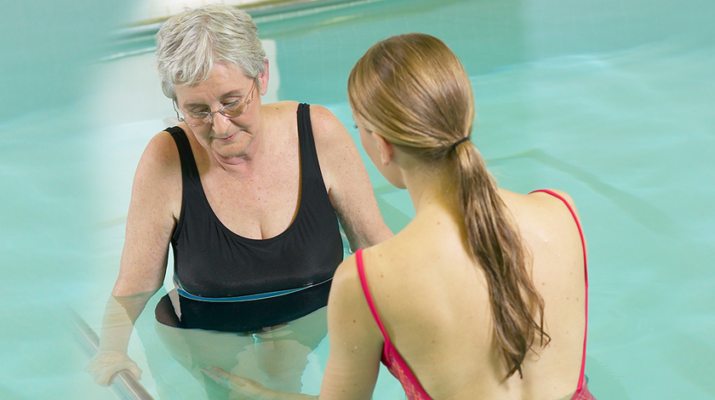By Deborah Jeanne Sergeant
For people recovering from an injury or joint surgery, aquatic therapy may be helpful in getting better sooner.

Like land-based (“dry”) physical therapy, aquatic therapy doesn’t require a physician’s prescription and most insurers cover treatment for a total of 30 days. At that point, a prescription would be required.
“Aquatic physical therapy is done in a heated water environment 94 to 96 degrees [F],” said Martin Koslosky, physical therapist with Amherst Physical Therapy in Buffalo. “It helps relax muscle and improve circulation through vasodilation. The buoyancy of the water helps patients unweight joints that are hurting them. Moving through the water provides resistance which helps strengthen muscles. Hydrostatic pressure helps with circulation. It’s good for people with rheumatoid arthritis, arthritis, fibromyalgia or people who can’t tolerate land-based therapy due to medical status.”
Amherst Physical Therapy uses aquatic therapy to work with pain in the back, hip, knee, ankle, shoulder and neck, among other reasons. In addition to rehabilitation, Amherst Physical Therapy offers “prehab” in anticipation of joint replacement surgery to help patients build strength without as much pain.
Aquatic physical therapy can also help people who need to lose weight but struggle to exercise because of their weight. Amherst Physical therapy has begun working with bariatric patients who often are instructed to lose weight before their procedure but cannot tolerate land-based exercise.
“It’s a great way to start and the patient can transfer to a land-based exercise program later on,” Koslosky said.
Aquatic physical therapy may involve more than just moving in the water. Physical therapists may use devices in the pool like noodles and flotation boards to help with movement or to encourage patients to stretch further and challenge themselves.
Most therapy pools are relatively shallow, as they’re not meant for diving or swimming laps. Some offer windows on the sides so therapists can see the patients’ movements without the distortion of looking through the water. Some have an optional current to help patients improve balance, strength and range of motion. Benches in the pool can allow patients to perform seated exercise.
Unlike land-based exercise, the pool challenges their posture, balance and core strength. But the water reduces risk of falls.
“You can do anything in the pool that you can on the land, but the offloading is beneficial to patients,” said Melanie Kehoe, doctor of physical therapy at Genesee Valley Physical Therapy in Webster.
The water also helps patients who have cerebral palsy, multiple sclerosis or impairment from a stroke if land physical therapy is too challenging.
People with fibromyalgia often see improvement in their ability to move.
“Fibromyalgia patients don’t necessarily think of aquatic physical therapy as a first line thought as far as treatment,” Kehoe said.
The same goes for people who want to start exercising but feel that traditional exercise is too hard because of chronic joint pain and fear injury.
Physical therapists offering aquatic therapy take continuing education credits to learn how to apply physical therapy principles in the water.
Few conditions contraindicate aquatic physical therapy. For example, an open wound or incision would prohibit it or health conditions that are sensitive to heat. Patients should ask their primary care providers about any concerns.

